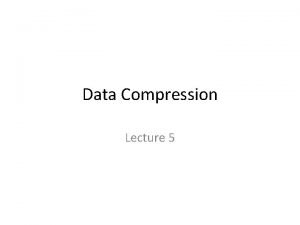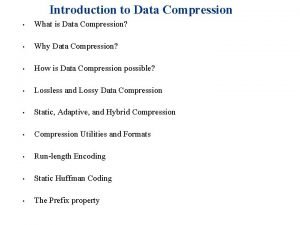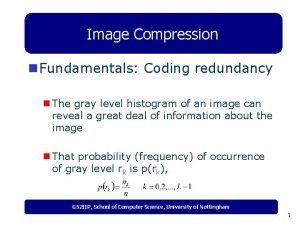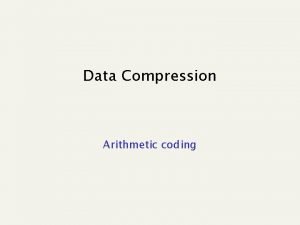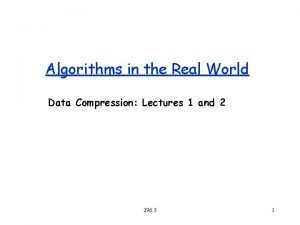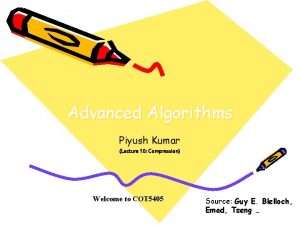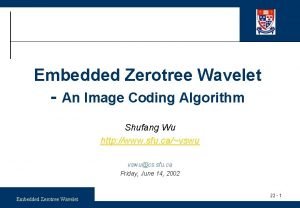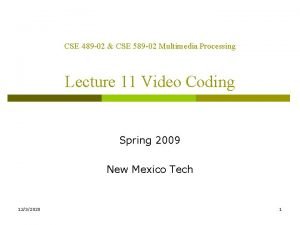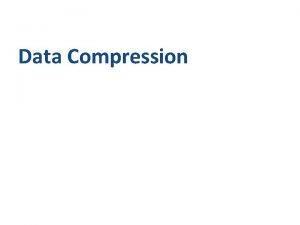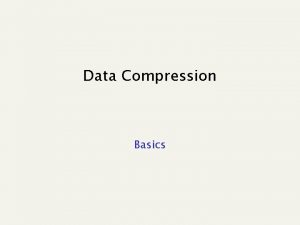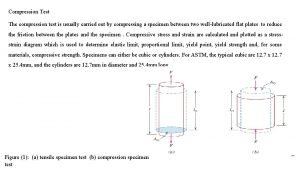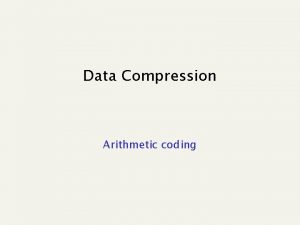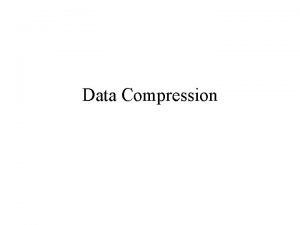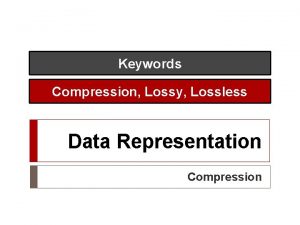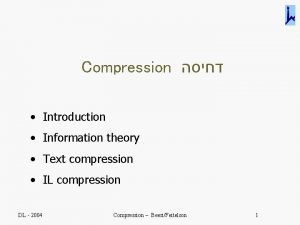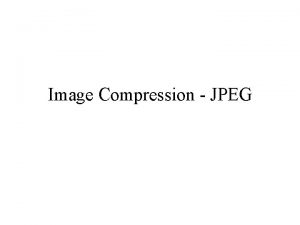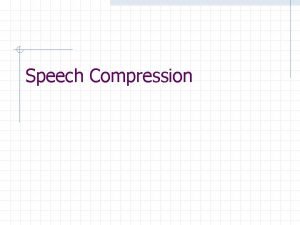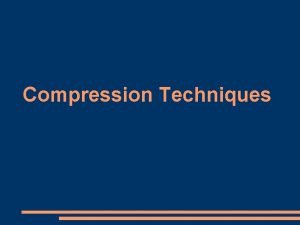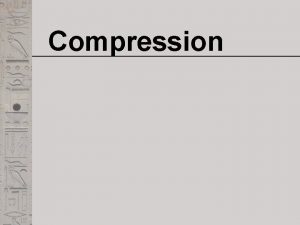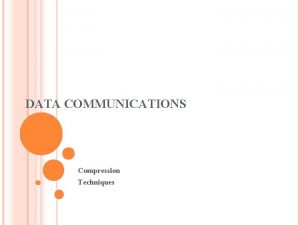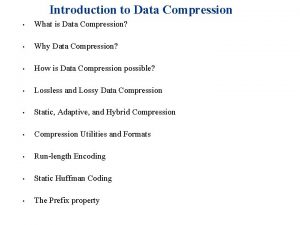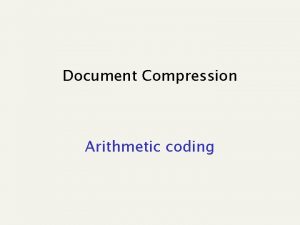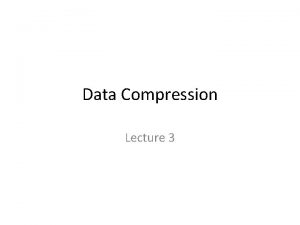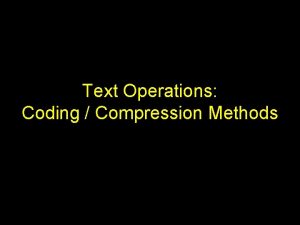Data Compression Arithmetic coding Arithmetic Coding Introduction Allows




![Arithmetic Coding To code a sequence of symbols c with probabilities p[c] use the Arithmetic Coding To code a sequence of symbols c with probabilities p[c] use the](https://slidetodoc.com/presentation_image_h/b15fbcae3dec855be17cdb7d647c0296/image-5.jpg)













![PPM + Arithmetic Tool. Box L+s s s’ L’ L p[ s|context ] s PPM + Arithmetic Tool. Box L+s s s’ L’ L p[ s|context ] s](https://slidetodoc.com/presentation_image_h/b15fbcae3dec855be17cdb7d647c0296/image-19.jpg)


- Slides: 21

Data Compression Arithmetic coding

Arithmetic Coding: Introduction Allows using “fractional” parts of bits!! Used in PPM, JPEG/MPEG (as option), Bzip More time costly than Huffman, but integer implementation is not too bad.

Arithmetic Coding (message intervals) Assign each symbol to an interval range from 0 (inclusive) to 1 (exclusive). e. g. 1. 0 c =. 3 0. 7 b =. 5 0. 2 0. 0 f(a) =. 0, f(b) =. 2, f(c) =. 7 a =. 2 The interval for a particular symbol will be called the symbol interval (e. g for b it is [. 2, . 7))

Arithmetic Coding: Encoding Example Coding the message sequence: bac 1. 0 0. 7 c =. 3 0. 55 0. 0 a =. 2 0. 3 0. 2 c =. 3 0. 27 b =. 5 0. 2 0. 3 a =. 2 b =. 5 0. 22 a =. 2 0. 2 The final sequence interval is [. 27, . 3)
![Arithmetic Coding To code a sequence of symbols c with probabilities pc use the Arithmetic Coding To code a sequence of symbols c with probabilities p[c] use the](https://slidetodoc.com/presentation_image_h/b15fbcae3dec855be17cdb7d647c0296/image-5.jpg)
Arithmetic Coding To code a sequence of symbols c with probabilities p[c] use the following: f[c] is the cumulative prob. up to symbol c (not included) Final interval size is The interval for a message sequence will be called the sequence interval

Uniquely defining an interval Important property: The intervals for distinct messages of length n will never overlap Therefore by specifying any number in the final interval uniquely determines the msg. Decoding is similar to encoding, but on each step need to determine what the message value is and then reduce interval

Arithmetic Coding: Decoding Example Decoding the number. 49, knowing the message is of length 3: 1. 0 0. 7 c =. 3 0. 7 0. 49 0. 2 0. 0 b =. 5 0. 55 c =. 3 0. 55 0. 49 a =. 2 The message is bbc. 0. 3 0. 2 0. 49 0. 475 b =. 5 a =. 2 c =. 3 b =. 5 0. 3 a =. 2

Representing a real number Binary fractional representation: Algorithm 1. x = 2 *x 2. If x < 1 output 0 3. else x = x - 1; output 1 So how about just using the shortest binary fractional representation in the sequence interval. e. g. [0, . 33) =. 01. 11 [. 33, . 66) =. 1 [. 66, 1) =

Representing a code interval Can view binary fractional numbers as intervals by considering all completions. We will call this the code interval.

Selecting the code interval To find a prefix code, find a binary fractional number whose code interval is contained in the sequence interval (dyadic number). Sequence Interval . 79 . 75 Code Interval (. 101) . 61 . 625 Can use L + s/2 truncated to 1 + log (1/s) bits

Bound on Arithmetic length Note that – log s +1 = log (2/s)

Bound on Length Theorem: For a text of length n, the Arithmetic encoder generates at most 1 + log (1/s) = = 1 + log ∏ (1/pi) ≤ 2+∑ j=1, n log (1/pi) = 2 + ∑k=1, | | npk log (1/pk) = 2 + n H 0 bits n. H 0 + 0. 02 n bits in practice because of rounding

Integer Arithmetic Coding Problem is that operations on arbitrary precision real numbers is expensive. Key Ideas of integer version: n n n Keep integers in range [0. . R) where R=2 k Use rounding to generate integer interval Whenever sequence intervals falls into top, bottom or middle half, expand the interval by a factor 2 Integer Arithmetic is an approximation

Integer Arithmetic (scaling) If l R/2 then (top half) Output 1 followed by m 0 s m=0 Message interval is expanded by 2 If u < R/2 then (bottom half) Output 0 followed by m 1 s m=0 All other cases, just continue. . . Message interval is expanded by 2 If l R/4 and u < 3 R/4 then (middle half) Increment m Message interval is expanded by 2

You find this at

Arithmetic Tool. Box As a state machine L+s c s’ L’ L (p 1, . . , p ) c ATB (L, s) ATB (L’, s’) Therefore, even the distribution can change over time

K-th order models: PPM Use previous k characters as the context. n n Makes use of conditional probabilities This is the changing distribution Base probabilities on counts: e. g. if seen th 12 times followed by e 7 times, then the conditional probability p(e|th) = 7/12. Need to keep k small so that dictionary does not get too large (typically less than 8).

PPM: Partial Matching Problem: What do we do if we have not seen context followed by character before? n Cannot code 0 probabilities! The key idea of PPM is to reduce context size if previous match has not been seen. n If character has not been seen before with current context of size 3, send an escape-msg and then try context of size 2, and then again an escape-msg and context of size 1, …. Keep statistics for each context size < k The escape is a special character with some probability. n Different variants of PPM use different heuristics for the probability.
![PPM Arithmetic Tool Box Ls s s L L p scontext s PPM + Arithmetic Tool. Box L+s s s’ L’ L p[ s|context ] s](https://slidetodoc.com/presentation_image_h/b15fbcae3dec855be17cdb7d647c0296/image-19.jpg)
PPM + Arithmetic Tool. Box L+s s s’ L’ L p[ s|context ] s = c or esc ATB (L, s) ATB (L’, s’) Encoder and Decoder must know the protocol for selecting the same conditional probability distribution (PPM-variant)

PPM: Example Contexts Context Empty Counts A B C $ = = 4 2 5 3 Context A B C Counts C $ A B C $ = = = = 3 1 2 1 1 2 2 3 Context AC BA CA CB CC String = ACCBACCACBA B k=2 Counts B C $ C $ A B $ = = = 1 2 2 1 1 1 2

You find this at: compression. ru/ds/
 Contoh axial coding
Contoh axial coding Open coding adalah
Open coding adalah Adaptive huffman code
Adaptive huffman code What is data compression
What is data compression Coding redundancy in image compression
Coding redundancy in image compression Data compression in data mining
Data compression in data mining Arithmetic coding example
Arithmetic coding example Arithmetic coding example
Arithmetic coding example Arithmetic coding example
Arithmetic coding example Adaptive arithmetic coding
Adaptive arithmetic coding Adaptive arithmetic coding
Adaptive arithmetic coding Image compression model in digital image processing
Image compression model in digital image processing History of qualitative research
History of qualitative research Coding dna and non coding dna
Coding dna and non coding dna Conclusion of self introduction
Conclusion of self introduction What is lossy data compression
What is lossy data compression Image compression
Image compression Which are uniquely decodable codes
Which are uniquely decodable codes Principles of data compression
Principles of data compression Data compression test
Data compression test Lossy compression
Lossy compression Jpeg: still image data compression standard
Jpeg: still image data compression standard


